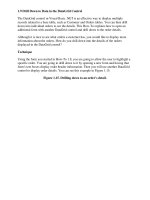What to expect on the gmat 9 ppt
Bạn đang xem bản rút gọn của tài liệu. Xem và tải ngay bản đầy đủ của tài liệu tại đây (74.81 KB, 6 trang )
Idiom Review
Many websites offer extensive lists of English language idioms. Try one of these sites for a helpful idiom review:
• Wayne Magnuson English Idioms: home.t-online.de/home/toni.goeller/idiom_wm/index.html
• The Idiom Connection: www.geocities.com/Athens/Aegean/6720
128
blame (someone) composed of concentrate on concerned with
for (something) conscious of consist of depend on/upon
complain about except for fond of from now on
congratulate on frown on/upon full of glance at (something)/glance
equal to grateful for in accordance with through (something
—
e.g.,
from time to time (something) insist on/upon a book)
grateful to (someone) inferior to knowledge of incapable of
in conflict interested in opposite of in the habit of
in the near future on top of related to next to
of the opinion regard to satisfied with prior to
proud of responsible for take care of rely on/upon
respect for suspicious of similar to
sorry for with regard to thank (someone) for
tired of (something)
Rule #18: Use idioms correctly.
Style
Style refers to the manner in which something is said or done. In writing, style is largely controlled by two
elements: sentence structure and word choice. Together, these two elements determine the tone, the level of
formality, and the level of detail, creating the overall feel of the text
—
smooth or choppy, formal or informal,
juvenile or sophisticated, friendly or sinister. These two elements also exert a great deal of control over the
readability and clarity of the text. A sentence that is grammatically correct but that has problems with its style
can still be difficult (even impossible) to understand.
To keep sentences clear and effective, writers should follow these guidelines for effective style:
1. Be concise.
2. Be precise.
3. Avoid ambiguity.
4. Use the active voice.
5. Use variety in sentence structure.
6. Avoid jargon and pretentious language.
You will certainly see sentences that violate guidelines 1
—
4 on the GMAT sentence correction questions.
You will probably not see many sentences violating guidelines 5
—
6, but these style guidelines are nonetheless
important and can help you write a better essay on the AWA section.
Be Concise
On the sentence level, in general, less is more. The fewer words you use to get your point across, the better.
Unnecessary words frustrate readers
—
they waste time and often cloud meaning. Notice, for example, how
cluttered and confusing the following sentence from the pretest is:
Creating a fundamental shift in American foreign policy was the Truman Doctrine, which was put forth
in 1947, and which established a “policy of containment” that framed our foreign policy as a battle
between the forces of good (America, along with other democratic societies) and the forces of evil (the
Soviet Union, along with other communist nations).
Notice the difference in length and clarity after wordiness and redundancy have been eliminated:
The 1947 Truman Doctrine created a fundamental shift in American foreign policy, establishing a “policy
of containment” that framed our foreign policy as a battle between the forces of good (America and
other democratic societies) and evil (the Soviet Union and other communist nations).
To eliminate wordiness, eliminate clutter and unnecessary repetition in your sentences.
Rule #19: Be concise. Avoid unnecessary repetition or wordiness.
E
LIMINATE CLUTTER
Avoid the following words, phrases, and constructions that add clutter to your writing.
■
Because of the fact that is an unnecessary and bulky phrase. Because is all you really need:
Because of the fact that my answering machine is broken, I didn’t get her message. (15 words)
Because my answering machine is broken, I didn’t get her message. (11 words)
■
That, who, and which phrases often needlessly clutter sentences and can usually be rephrased more
concisely. Try turning the that, who, or which phrase into an adjective:
It was an experience that was very rewarding. (8 words)
It was a very rewarding experience. (6 words)
– SENTENCE CORRECTION–
129
■
There is, it is. The there is and it is constructions avoid directly approaching the subject and use unnec-
essary words in the process. Instead, use a clear agent of action:
It was with much regret that I had to postpone my education. (12 words)
I greatly regretted having to postpone my education. (8 words)
Regrettably, I had to postpone my education. (7 words)
There is one more thing I should tell you. (9 words)
I should tell you one more thing. (7 words)
■
The word that often clutters sentences unnecessarily. Sentences will often read more smoothly
without it:
I wish that I had taken the opportunity that I was given more seriously. (14 words)
I wish I had taken the opportunity I was given more seriously. (12 words)
I wish I had taken the opportunity more seriously. (9 words)
■
I am of the opinion that, I believe, I feel, and other similar phrases are unnecessary unless you are dis-
tinguishing between what you think and what someone else thinks.
I am of the opinion that the flat tax is a good idea. (13 words)
I feel that the flat tax is a good idea. (10 words)
I believe the flat tax is a good idea. (9 words)
The flat tax is a good idea. (7 words)
A
VOID UNNECESSARY
REPETITION
When writers are not sure they have been clear, or when they are simply not being attentive to the need for
concise writing, they often repeat themselves unnecessarily by saying the same thing in two different ways.
This happens in the following example:
The willow beetle is red in color and large in size. (11 words)
Red is a color, so it is not necessary to say “in color.” Likewise, large is a size
—
so “in size” is a waste of
words. Here is the sentence revised:
The willow beetle is red and large. (7 words)
Here’s another example of unnecessary repetition:
The Bill of Rights guarantees certain freedoms and liberties to all citizens, rights that cannot be taken
away. (18 words)
– SENTENCE CORRECTION–
130
If it’s a guarantee, then those rights cannot be taken away
—
so the whole second half of the sentence
repeats unnecessarily. Similarly,“freedom” and “liberties” are essentially the same thing, so only one of those
words is necessary. Here is the revised sentence:
The Bill of Rights guarantees certain freedoms to all citizens. (10 words)
Be Precise
Writing has more impact when it is filled with exact words and phrases. This means substituting a strong,
specific word or phrase for a weak or 2 modified word or phrase. (A modifier is a word that describes, such
as red balloon or very juicy apple.) A lot of wordiness can be trimmed by using exact words and phrases, too.
Notice how attention to word choice cuts back on wordiness and creates much more powerful sentences in
the following example:
He walked quickly into the room.
He rushed into the room.
He raced into the room.
He dashed into the room.
He burst into the room.
Each of these verbs has much more impact than the phrase walked quickly. These exact verbs create a
vivid picture; they tell us exactly how he came into the room.
Exact nouns will improve your sentences, too. Here’s an example:
The dog escaped down the street.
The pit bull escaped down Elm Street.
Again, the specific nouns help us see what the writer is describing
—
they bring the sentence to life.
Adjectives, too, should be precise. Instead of writing
I am very frightened.
Try using an exact adjective:
I am petrified.
“Petrified” means “very frightened”
—
and it is a much more powerful word.
Rule #20: Be precise. Use exact words.
– SENTENCE CORRECTION–
131
Ambiguity
Ambiguous means having two or more possible meanings, so, of course, ambiguous words and phrases inter-
fere with clarity. Ambiguity can be caused by poor word choice, misplaced modifiers, and unclear pronoun
references. Take a look at this sentence, for example:
The photographer shot the model.
This sentence can be read in two ways: that the photographer took (“shot”) pictures of the model with
his camera, or that he shot the model with a gun. You can eliminate this ambiguity by addressing the word
choice and revising the sentence as follows:
The photographer took pictures of the model.
Took pictures is not as powerful a phrase as the verb shot, but at least no ambiguity appears.
Another type of ambiguity happens when a phrase is in the wrong place in a sentence. For example, look
at the following sentence:
The woman ate the sandwich with the blue hat.
Here, the word order, not an ambiguous word, causes the confusion; the modifier with the blue hat is in
the wrong place (a misplaced modifier). Did the woman eat her sandwich with her hat? Or was the woman
wearing a blue hat as she ate the sandwich? Because the phrase with a blue hat is in the wrong place, the sen-
tence becomes unclear. The sentence should be revised to read:
The woman with the blue hat ate the sandwich.
Ambiguity can also result from unclear pronoun references. Pronouns are used to replace nouns (I, you,
he, she, it, we, they). Here is an example of an unclear pronoun reference:
In Heart of Darkness, Conrad has Kurtz tell Marlow his revelation right before he dies on the steamboat.
He appears twice in this sentence and could be referring to three different people: Conrad, Kurtz, and
Marlow. Clearly, this sentence needs to be revised:
In Conrad’s Heart of Darkness, Kurtz tells Marlow his revelation right before he dies on the steamboat.
Here is another kind of unclear pronoun reference:
It has been years since they tore down that old building.
– SENTENCE CORRECTION–
132
This is an example of a common pronoun error: using a vague they when specific people are behind the
action. You may not know exactly who those people are, but you know enough to say something like the
following:
It has been years since a demolition crew tore down that building.
People are always behind actions, and your sentences should indicate this.
Rule #21: Avoid ambiguity. Make sure word choice and pronoun references are clear and modifiers are
properly placed.
Active and Passive Voice
In most cases, effective writing will use the active voice as much as possible. In an active sentence, the sub-
ject directly performs the action:
J
ames filed the papers yesterday.
J
in Lee sang the song beautifully.
In a passive sentence, on the other hand, the person or thing who actually completes the action of the
sentence is put into a prepositional phrase. Rather than performing the action, the true subject is acted upon:
The papers were filed b
y James yesterday.
The song was sung beautifully b
y Jin Lee.
Active sentences are more direct, powerful, and clear. They often use fewer words and have less room
for confusion. However, sometimes the passive voice is preferable, such as when the source of the action is
not known or when the writer wants to emphasize the recipient of the action rather than the performer of
the action:
Protective gear must be worn by everyone entering this building.
As a general rule, however, sentences should be active whenever possible.
Using the active voice means making sure a sentence has a clear agent of action and a direct approach.
For example, compare the following sentences:
Passive: The patient was given the wrong prescription.
Active: Someone gave the patient the wrong prescription.
– SENTENCE CORRECTION–
133









